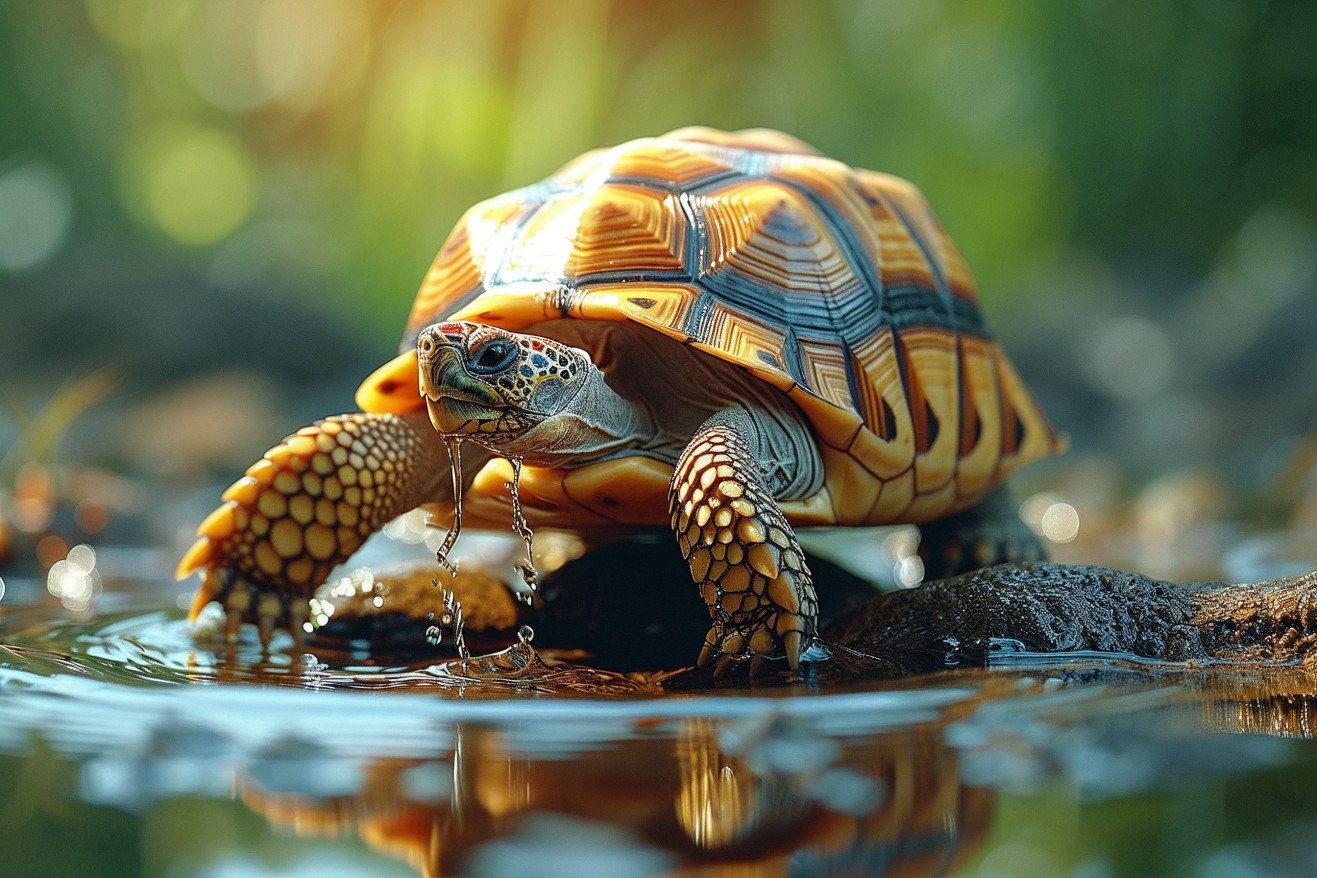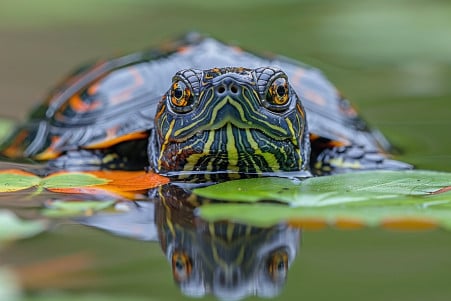Do Tortoises Swim? Investigating Terrestrial Adaptations and Aquatic Constraints
10 February 2024 • Updated 16 February 2024

While turtles are known for their swimming abilities, what about tortoises? Unlike turtles, tortoises are not built for swimming because of their heavy, high-domed shells and strong, unwebbed limbs. As a result, tortoises are primarily terrestrial and can’t swim, especially in deep water. However, there are a few exceptions, like the leopard tortoise, which can float and use its limbs to paddle.
In this deeper dive into the world of tortoises, we investigate research from herpetology, evolutionary biology, and animal behavior. This research explains the morphological and behavioral characteristics of tortoises, their unique adaptations to life on land, and their interactions with water. This information helps explain why tortoises are such poor swimmers and how evolution has impacted their swimming abilities.
Do tortoises swim?
Tortoise Anatomy That’s Adapted to Land
Tortoise anatomy is a prime example of how evolution has shaped animals to be perfectly suited to their environment. Unlike sea turtles, tortoises have a large, heavy shell that is shaped like a dome, which makes it difficult for them to swim.
As described by Britannica, the family Testudinidae, which tortoises belong to, is known for its elephantine or columnar hind limbs and forelimbs that lack the flipper-like structure that would make them more effective for swimming. Instead, these limbs are well-suited for the tortoise’s life on land, where they can move across a variety of different landscapes.
The tortoise’s respiratory system is another example of how tortoises are better adapted to life on land than in the water. Tortoises can’t stay underwater for long periods of time because they don’t have the specialized lungs and the ability to absorb oxygen through their skin or mouth that turtles do.
Turtles have a streamlined body with webbed feet and a respiratory system that allows them to extract oxygen from the water, which enables them to stay underwater for long periods of time.
On the other hand, the tortoise’s heavy shell and solid, non-webbed feet aren’t built for floating or propelling the animal through the water. This difference is important to understand when you’re trying to figure out why tortoises are so well-suited to life on land, where their anatomy gives them an advantage, rather than in the water.
As we learn about the anatomical adaptations that make tortoises unique, it becomes clear that their bodies are closely tied to their terrestrial environment.
Tortoises and Their Terrestrial Environments: A Symbiotic Relationship
Tortoises are tied to the land and exist in a symbiotic relationship with their terrestrial environments, which have influenced their physiological adaptations. The gopher tortoise, for instance, is a keystone species in the sandy, fire-prone landscapes of Florida, according to the Climate Adaptation Explorer.
Its shovel-like front legs are perfectly designed for digging, a characteristic that is not well-suited for an aquatic existence. The absence of water in their environments has limited their ability to swim, as their habitats don’t require or support the development of aquatic skills.
In a similar way, the desert tortoise is well-adapted to the arid conditions of the Mojave Desert, according to The Nature Conservancy. This species spends much of its time seeking refuge from the desert’s extreme temperatures, which emphasizes its adaptation to life on land rather than in the water. These tortoises are a keystone species in their ecosystems, and their burrows provide homes for a variety of other desert species.
The Nature Conservancy and other groups are working to conserve and restore the tortoises’ natural habitats, recognizing the importance of these animals in their terrestrial environments. The physical characteristics and behaviors of tortoises are a direct result of the environment they inhabit, one in which water is scarce and the land is the place where life happens. This knowledge is important for informing conservation efforts and ensuring that these amazing animals continue to exist.
Tortoise Water Interaction
Tortoises may react to water in a variety of ways, from curiosity to fear. ExoticDirect notes that some of the reactions tortoises have to water include urination when scaredwhich is believed to be a defense mechanismand pulling their head into their shell as a passive defense. Both of these reactions are signs of stress and discomfort, indicating that water should be introduced to tortoises in a way that is safe and comfortable.
One of the most obvious dangers of submerging a tortoise in water is the risk of drowning. Tortoises are not natural swimmers, and their heavy shells make it difficult for them to stay afloat. This means that any water source that is made available to a pet tortoise should be shallow and easy to get out of.
Tortoises may react to water by hissing or pulling their head into their shell. These are signs that the tortoise is uncomfortable and feels threatened by the water. Garden State Tortoise explains that it’s important to understand these natural reactions and make sure that tortoises have access to water for hydration without being forced into situations that may be stressful or dangerous.
This means that tortoise owners should provide a shallow water dish for drinking and the occasional soak. This allows the tortoise to get the hydration it needs while still respecting its natural aversion to deeper water. This kind of interaction with water is healthy and safe for tortoises, and it ensures that their needs are met while still respecting their natural instincts.
The Evolution of Tortoises and the Constraints of Water
The forces of evolution have shaped the evolutionary history of tortoises, leading to a number of unique adaptations that have helped them survive on land. One study published in Cladistics even suggests that giant tortoises evolved their large size multiple times on different continents, not just on islands as previously believed. Genetic and osteological evidence backs up this claim and shows that tortoises have always been primarily terrestrial with a limited ability to swim.
Natural selection has continued to refine the terrestrial adaptations of tortoises, with tortoises evolving their characteristic heavy, domed shells and columnar legs, which are not well-suited for swimming. According to ScienceDaily, this means that giant tortoises, including those from the Galapagos, were probably better adapted to overland migration and surviving long periods without food and water, which helped them disperse to islands. However, their swimming abilities have always been limited at best.
The biogeographical implications of tortoises’ terrestrial adaptations also call into question some island colonization theories. For example, the British Chelonia Group points out that the Aldabran tortoises probably originated in the Seychelles, which suggests a more complicated colonization history that didn’t depend on the ability to swim.
The complex evolutionary history of tortoises shows how adaptable they are and highlights the need to protect these animals, many of which are now endangered due to human-driven habitat destruction.
Why Can’t Tortoises Swim? They’re Terrestrial Animals
In the end, the evidence we’ve covered in this article makes it clear that tortoises are the epitome of terrestrial animals. Their heavy, domed shells and solid, pillar-like legs are classic terrestrial adaptations that make swimming impossible. The absence of webbed feet and the way their shells are built to hinder buoyancy are further evidence that most tortoises are not meant for the water.
From the physiological to the anatomical to the behavioral, we’ve shown how tortoises’ traits have combined to make them poor swimmers. These traits have been shaped by their evolution and the environments they live in, which have been everything from arid deserts to tropical rainforests, but never an environment where swimming would be an important skill.
The implications of these findings go beyond understanding tortoises and their relationship to water. They also have implications for conservation and the care of tortoises as pets.
They show that it’s important to make sure the environments tortoises are kept in are as close to their natural habitats as possible, in terms of both their physical and behavioral needs. They also show that it’s important to appreciate and preserve the natural limitations and abilities of different species, including the fact that not all species are meant to be amphibious.
In learning about these amazing animals, we can also appreciate the diversity of life and the complex adaptations that have allowed each species to find its place in the patchwork of ecosystems that covers our planet.


